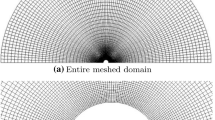Abstract
Time-accurate numerical simulations are used to study the dynamic development of oblique detonations on accelerating projectiles in ram accelerators. These simulations show that the oblique detonation can be stabilized on the projectile. The high pressure generated behind the detonation can result in accelerations up to 106G and propel the projectile to velocities higher than 4.0 km/s. The detonation structure on the projectile is sensitive to the projectile geometry. A small change in the projectile shape is sufficient to alter the overall detonation structure and significantly affect the pressure distribution on the projectile. In order to maximize the thrust, an appropriate projectile shape has to be chosen to generate the detonation structure just behind the widest part of the projectile body. The projectile acceleration also has strong effects on the flow field and the detonation structure. During the acceleration, the location of the oblique detonation moves upstream from one reflected shock to another. However, one the detonation is stabilized behind the upstream shock, it remains at the new location until the transition to the next upstream shock occurs. In the simulations, the Non-Inertial-Source (NIS) technique was used to accurately represent of the projectile acceleration. Also, the Virtual-Cell-Embedding (VCE) method was employed to efficiently treat the complex projectile geometry on cartesian grids.
Similar content being viewed by others
References
Boris JP, Book DL (1976) Solution of the Continuity Equations by the method Flux-Corrected Transport. Methods in Computational Physics 16: 85
Bruckner AP, Knowlen C, Hertzberg A, Bogdanoff DW (1991) Operational Characteristics of the Thermally Choked Ram Accelerator. J Propulsion Power 7: 5
Hertzberg A, Bruckner AP, Bogdanoff DW, Knowlen C (1987) The RAM Accelerator and its applications: A New Approach for Reaching Ultrahigh Velocities, the 16th Symposium on Shock Tubes and Shocks Waves, VCH, Aachen, West Germany
Hertzberg A, Bruckner AP, Bogdanoff DW, Knowlen C (1989) Thermodynamics of the RAM Accelerator, the 17th Symposium on Shock Tubes and Shocks Waves, Lehigh University
Kailasanath K, Oran ES, Boris JP, Young TR (1985) Determination of Detonation Cell Size and the Role of Transverse Waves in Two-Dimensional Detonation. Combustion and Flame 61: 199
Kruczynski D (1993) New Experiments in a 120-mm Ram Accelerator ator at High Pressures, AIAA-93-2589
Landsberg AM, Boris JP, Sandberg W, Young TR (1993) Naval Ship Superstructure Design: Complex Three-Dimensional Flows Using an Efficient, Parallel Method, Proceedings from High Performance Computing 1993: Grand Challenges in Computer Simulations, 1:15, Society for Computer Simulations, San Diego
Li C, Kailasanath K, Oran ES (1991) Oblique Detonations in Ram Accelerators, 28th JANNAF Combustion Meeting, San Antonio, Taxes, CPIA, 573:305
Li C, Kailasanath K, Oran ES (1992a) Stability of Oblique Detonations in Ram Accelerators, AIAA-92-0089
Li C, Landsberg AM, Kailasanath K, Oran ES Boris JP (1992b) Numerical Simulations of Reactive Flows in Ram Accelerators, 29th JANNAF Combustion Meeting, Hampton, Virginia, CPIA, 593:279
Li C, Kailasanath K, Oran ES (1993a) Structure of Reaction Waves behing Oblique Shocks. Progress in Astronautics and Aeronautics 153:231
Li C, Kailasanath K, Oran ES (1994) Detonation Structures behind Oblique Shocks, Physics of Fluids A, 6: 1600
Li C, Kailasanath K, Oran ES (1993c) Effects of Boundary Layers on Oblique-Detonation Structures, AIAA-93-0450
Oran ES, Boris JP, Young T, Flanigan M, Burk T, Picone M (1981) Numerical Simulations of Detonations in Hydrogen-air and Methane-air Mixtures, the 18th International Symposium on Combustion
Author information
Authors and Affiliations
Rights and permissions
About this article
Cite this article
Li, C., Kailasanath, K., Oran, E.S. et al. Dynamics of oblique detonations in ram accelerators. Shock Waves 5, 97–101 (1995). https://doi.org/10.1007/BF02425040
Received:
Accepted:
Issue Date:
DOI: https://doi.org/10.1007/BF02425040




